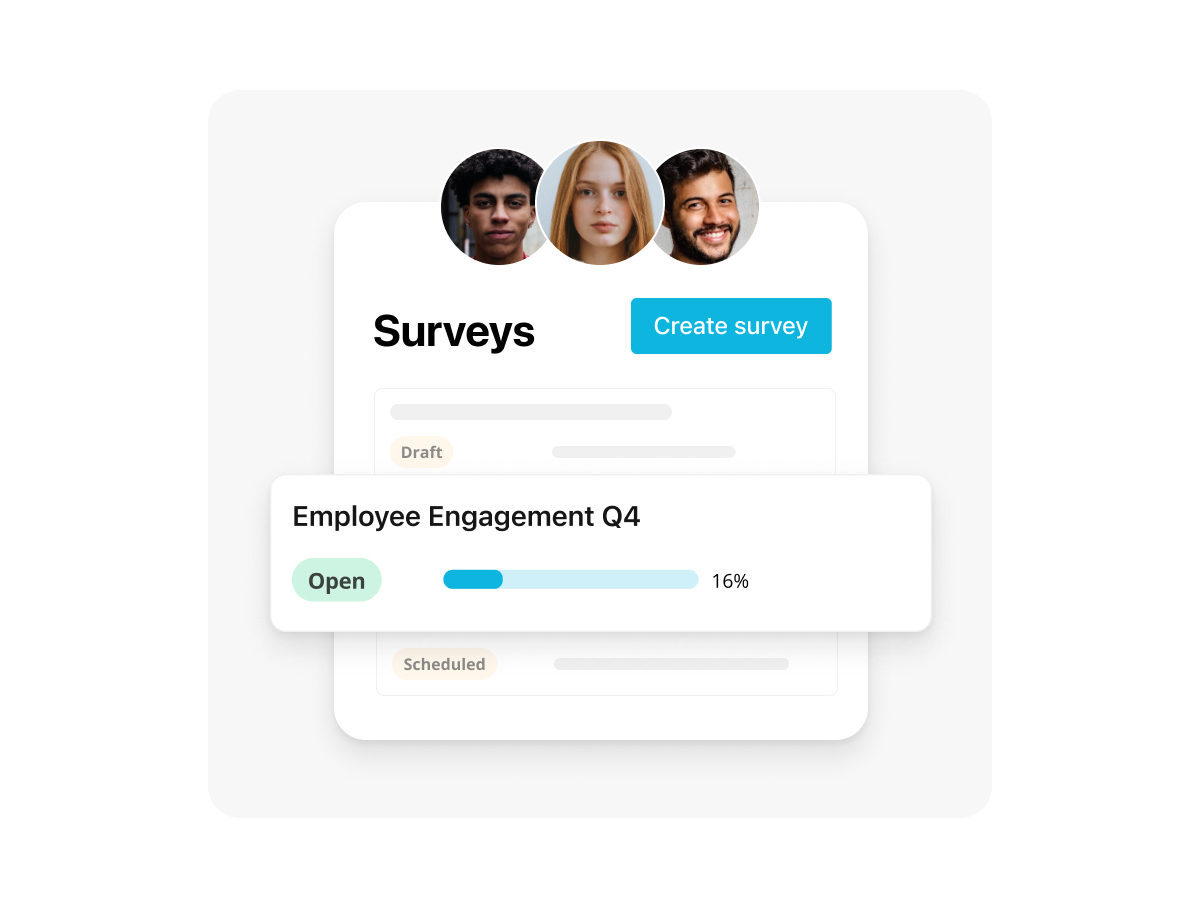Employee burnout: causes, signs and strategies

Employee burnout is an incredibly important topic. After all, your organisation may be burning out your employees without even noticing it.
Whether it’s multitasking, sending emails after work, or virtual meeting marathons, burnout can come in so many different shapes and sizes — but it can all have the same effect.
Demotivated workers, a lack of productivity and poor business performance. In this article, we get to the heart of employee burnout signs, causes and strategies to help prevent it from becoming an issue in your organisation.
How are your employees feeling? Download our employee survey template today to find out.
What is employee burnout?
Employee burnout is a specific type of workplace stress, acknowledged even by the World Health Organization (WHO), where workers feel general dissatisfaction with their work and multiple levels of exhaustion, including:
Mental exhaustion
Physical exhaustion
Emotional exhaustion
The end result is an employee who no longer feels up to the task of their daily work, is generally disinterested in their work or profession in general, leading to mental distance and overall reduced productivity.
Organisationally, this can lead to higher staff turnover and attrition, lower employee engagement scores and a negative impact on workplace culture that can affect the business’ performance.
How common is employee burnout?
A report from Mental Health UK found that one in five UK workers took time off for stress-related mental health concerns in 2023.
A report by Vitality, a health and life insurer, found that Gen Z and young millennials are missing the equivalent of one day per week of work due to mental health concerns, with the majority of lost hours due to ineffective work rather than entire sick days.
In terms of scale, a study run by the Health and Safety Executive of the UK government found that approximately 17.9 million working days are lost as a byproduct of workplace stress, depression or anxiety.
And the economic impact is huge: poor health costs the UK economy an estimated £138 billion per year due to absence and low productivity.
It can also be seasonal, with some experts suggesting that burnout may even spike at certain points of the year (January 2021, for example), based on search trends.
What are the most common causes of employee burnout?
Employee burnout doesn’t simply appear out of thin air, it has to be brought about. Typically, this is due in part to the way an organisation operates and how your people processes respond to your people’s needs.
When things go awry, burnout can prevail. Here are some of the most common causes of burnout for employees:
Too much work: Too much to do, with too little time. When employees are dealing with overwork, this can be one of the most common causes of burnout. After all, when your tasks start piling up, without any relief, it can be incredibly overwhelming and cause people to shut down completely.
Not enough work: On the other hand, a lack of work can also lead to burnout. This doesn’t mean not enough work, at least not necessarily, but a lack of complexity when it comes to tasks. Burnout can occur when employees don’t feel as connected to their work, which can happen if they repeat the same tasks, over and over again.
Compensation: When employees don’t feel like their compensation lines up with their work, or the amount they are being asked to work, things can get complicated very quickly. You can influence this with the proper remuneration package and bonus structure frameworks in place.
Environment and management: Both workplace culture and management style can have a distinct effect on burnout. If employees don’t feel like they enjoy coming into the office, or even opening their laptop each morning to start work, then the feeling of burnout can come about quickly. The same is true if their managers pressure or micromanage them.
Is your corporate culture causing burnout? Download our guide to the subject today.
What are the typical signs of employee burnout?
Signs are results of employee burnout are typically intertwined. Here is how you can tell if your employees are burned out, based on the key performance indicators of your business:
Sickness: Employee absenteeism rates, due to illness, may rise, costing your company working days (and, as per the previous data point, that adds up to 17.8 million working days UK-wide).
Mistakes: When employees are experiencing burnout, their day-to-day work may be more ridden with mistakes as they are less passionate or careful about what they are doing.
Motivation: Less motivated, less innovative and less productive. If you feel like there has been a brain drain at your company and no one has left, then you may be dealing with burnout.
Turnover: Higher staff turnover and attrition rates, as well as employees leaving the company more quickly, can result in not only less talent but higher overall recruiting costs.
Customers: If your customer service scores have been dropping, it may be due to burnout. Your employees may not be approaching or responding to customers in a positive fashion.
Employee burnout, therefore, has a distinct effect on the bottom line. That is why defining burnout and figuring out ways to prevent it, is so crucial for modern companies.
Preventing employee burnout in five steps
Massages, training and seminars on health — all of these are good, but they don’t really get to the heart of the issue. You see, if you want to prevent employee burnout, you need to get straight to the source.
Here are five steps to help craft a ‘burnout prevention framework’ for your organisation:
1. Put an end to multitasking
Think of multitasking as a relic of a bygone era. After all, studies have shown that the process of switching between tasks does not make humans more productive — it makes us less productive and more prone to stress!
In this sense, switching between tasks doesn’t do us any good. So your organisation needs to find unique ways to keep people from needlessly switching between things.
An easy example would be to encourage that employees to’ mute’ their various communication tools. This way, they are mindfully checking in on messages, rather than allowing chimes or bells to take them away from their work.
Fewer interruptions and less switching mean more productivity, focus and happier employees. Overall, this is a key element of how the way we view strategic work as a competitive advantage for your business.
2. Have management set an example
It’s not only enough to suggest eliminating multitasking, it needs to be an initiative lived by leaders in your organisation. This is especially true when it comes to managing remote teams (who risk being ‘always on,’ day or night).
Have leaders practice it themselves first, promote it to employees and have them set a good example so that your workforce can feel empowered to do the same.
It could even take the shape of a company-wide initiative. For example, ‘meeting-free Mondays’ could become the standard in your business. That way, you eliminate meetings for one day so everyone can focus.
3. Define, change and optimise company values
Your company’s core values are one of the clearest expressions of what matters to your company and what your company expects of your workers. So, if you don’t have them at all, that should be your first step.
If you do have them, revisit them. But don’t just update them for the sake of doing so, you need to also consider how you are living those values and how they translated into lived employee experiences.
Preventing burnout from happening means that everyone in your company knows that their health comes first. Expressing that as part of your company values, while making it real (check out our next step), is imperative.
4. Make work-life balance real
In the past decade or so, work-life balance has been an incredibly important topic. Not only for employees but for organisations who need to help facilitate this balance. To prevent burnout, they need to be the ones playing an active role.
What does this look like? For your organisation, it could consist of:
Strict no-emailing policies on the weekend.
Clear sign-off teams for members so they finish work strong.
Self-care days to let people focus on just themselves.
An expectation that responses come in quality, not in time.
5. Keep in contact
This is especially true for HR and People leaders and it’s how do you keep the pulse of your organisation? Preventing burnout starts by identifying when and how it is happening.
So, in order to have a proper prevention program in place, you need to keep up to date with your employees. Schedule review meetings and appraisals, collect feedback, send out pulse surveys and determine how people are feeling.
If you find that people are satisfied, great! But, if they are stressed or overworked, you may need to quickly think of initiatives to help people keep that spark before getting burned out.
Effortlessly create and analyse surveys

Measure your employee engagement with a seamless survey process. Now you can design, send and analyse your next employee survey in one place.
See it in actionHow do you overcome employee burnout?
It’s quite simple. You can overcome employee burnout in your organisation by recognising it, understanding it and thinking about the ways that you may be contributing to it (and, vice versa, how you can prevent it).
That means taking part in strategic initiatives to not only decrease burnout, in general, but the risk of burnout, as well.
Do you know how your employees currently feel?
The first step can be running an employee engagement survey to understand how your employees feel, current engagement levels and if burnout is potentially a risk for your organisation.
More specifically, you can ask your employees about:
Their current workload
How they feel about your organisation’s culture
How they would rate their relationship with their manager
If they have the proper work-life balance in place
Ready to get started on identifying and preventing employee burnout? Download our free employee survey template by clicking the button below.

